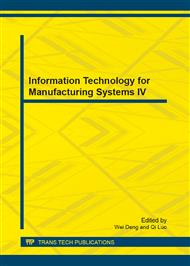[1]
Eyerman C E, Shea J F. A systems engineering approach to disturbance minimization for spacecraft utilizing controlled structures technology MIT SERC Report (1990).
Google Scholar
[2]
Bialke B. High fidelity mathematical modeling of reaction wheel performance. Proceedings of the 21st Annual American Astronautical Society Guidance and Control Conference, Univelt Inc Publishing , San Diego, USA (1998), pp.483-493.
Google Scholar
[3]
Masterson R A, Miller D W. Development and validation of empirical and analytical reaction wheel disturbance models MIT SERL Report (1999).
Google Scholar
[4]
Sun Jie, Zhao Yang, Wang Benli. Development of precise disturbance model of reaction wheel assembly on a spacecraft. Journal of Harbin Institute of Technology, Vol. 38 (2006), pp.520-522.
Google Scholar
[5]
Zhang Pengfei, Cheng Wei Disturbance modeling and parameter identification of reaction wheel assembly on spacecraft. Journal of Beijing University of Aeronautics and Astronautics, Vol. 36 (2010).
Google Scholar
[6]
Vapnic V N. The nature of statistical learning theory. Springer Verlag, New York (1995).
Google Scholar
[7]
Mita A, Fujimoto A. Active detection of loosened bolts using ultrasonic waves and support vector machines. Proceedings of the 5th International Workshop on Structural Health Monitoring (2005).
Google Scholar
[8]
Zhang J, Sato T, Iai S, et al. A pattern recognition technique for structural identification using observed signals: linear case studies. Engineering Structures, Vol, 30-15(2008), pp.1439-1446.
DOI: 10.1016/j.engstruct.2007.08.006
Google Scholar
[9]
Rojo, Alvarez J L, Martinez , Ramon M, de Prado, Cumplido M, et al. Support vector method for robust ARMA system identification. IEEE Transactions on Signal Processing, Vol. 52 (2004), pp.155-164.
DOI: 10.1109/tsp.2003.820084
Google Scholar
[10]
Suykens J A K, Vandewalle J, de Moor B. Optimal control by least squares support vector machines . Neural Network, Vol. 14- 1 (2001), pp.23-35.
DOI: 10.1016/s0893-6080(00)00077-0
Google Scholar
[11]
Suykens J A K, de Brabanter J, Lukas L, et al. Weighted least squares support vector machines: robustness and sparse approximation. Neuro computing, Vol. 48 (2002), pp.85-105.
DOI: 10.1016/s0925-2312(01)00644-0
Google Scholar
[12]
Fu Zhichao, Cheng Wei, Xu Cheng. LS-SVM based Method for Modal Parameter Identification. ACTA AERONAUTICA ET ASTRONAUTICA SINICA, Vol. 30 (2009).
Google Scholar


